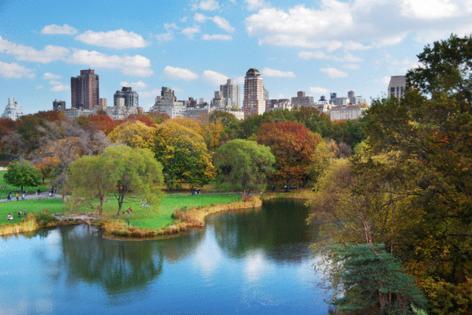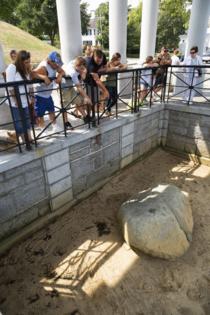There's More Than One Thing To See at Popular Destinations
By Victor Block
Countless people around the world the world dream of visiting New York City's Times Square, and many of them do, which is one reason why the neighborhood is included on lists of most-overrated places in the United States.
That's not to say that if you haven't been to the enclave nicknamed "Crossroads of the World" and "Center of the Universe" or have been there in the past and long to do so again that you should remove it from your bucket list. What it does mean is that you should be aware of the reasons that area shows up on inventories of famous sites throughout the United States that in some ways fall short of their stellar reputations. It's also good to know what else there is to see once you've checked off the main event.
Trip Advisor, The Travel and Far & Wide are among websites that have listed destinations and specific attractions that don't always live up to their high repute. For those who wish to see them anyway, these sources suggest being aware of the drawbacks so you aren't too disappointed when you arrive.
Their advice has served me well over the years when I took my children and other first-time visitors to New York to experience Times Square. Forewarned about its downsides, we accepted them as the price pay to in order to enjoy basking in the bright lights, taking a behind-the-scenes tour of Broadway theaters and admiring the Empire State Building, Rockefeller Center and other renowned landmarks. We also explored other Big Apple neighborhoods and Central Park, which have their own appeals with far fewer people.
Despite the familiar phrase "Remember the Alamo," many visitors to that structure in San Antonio, Texas, find it to be easily forgotten. Granted, the story of the small group of fighters for the independence of Texas from Mexico who died for their cause is inspiring, but given its fame, the 18th-century Franciscan mission building itself can be underwhelming. Furthermore, the surrounding area is tourist-trappy, in contrast with other historic missionary posts located nearby.
Another structure, the Gateway Arch in St. Louis, designed by legendary architect Eero Saarinen, has a lot going for it. This largest such edifice in the world is 63 stories high and offers views of up to 30 miles away. Exhibits in the museum at its base cover various aspects of the nation's westward expansion as well as information about construction of the arch.
Lines to ride to the top can be long, however, and the pod that makes the journey is tiny. Once there, crowds can make it challenging to peer out of the very narrow windows. Some sightseers prefer to take advantage of the city's inviting list of museums, gardens and parks.
The glitzy casinos, megahotels and lavish shopping malls that line the Strip in Las Vegas make it one of the most famous entertainment destinations in the country. They also attract hordes of out-of-staters seeking fun in many forms. In the words of one resident, "It can be fun for 21-year-olds, but that fades quickly when you encounter the heat, hordes of people and go-go activity." A much more sedate alternative is the drive through nearby Red Rock Canyon, a conservation area of desert landscape, massive flame-hued rock formations and sandstone cliffs and peaks.
Some well-known rock formations don't live up to their billings, either, and may even have a dark side to their creation. Granted, the 60-foot-tall sculpted heads of four presidents -- George Washington, Thomas Jefferson, Abraham Lincoln and Theodore Roosevelt -- on Mount Rushmore in South Dakota comprise an impressive memorial. An often-overlooked part of the story is that it occupies land set aside by the U.S. government for Native American tribes, but when gold was discovered in the area, they reneged on that promise.
Once admirers have gazed at the carving, there's little else to do at the site. The eroded buttes and pinnacles of Badlands National Park, however, and Custer State Park, which is home to bison, elk, cougars and other wildlife, are worth a look-see.
Plymouth Rock is much smaller than the Mount Rushmore sculpture but even larger in lore. That is so despite the fact that no historical evidence exists to confirm that the stone was the first place where the Pilgrims set foot in the New World. It wasn't until 1741 -- 121 years after the arrival of the Mayflower -- that a boulder was pointed out as the precise spot where the wayfarers landed. As one skeptical viewer reported after seeing the 40-pound stone that is on display today, inscribed with the year (1620) of the Pilgrims' landing: "It's just a rock."
Close by in the Massachusetts town are the Mayflower II, a replica of the famous ship; Plimoth Plantation, a living history exhibit that re-creates life in the original Plymouth Colony; and Pilgrim Hall Museum, which opened in 1824 and is the oldest continuously operating public collection in the country.
When thinking of visiting one of the famous iconic sites around the United States, it's wise to do a bit of research in advance. Check out what others have said about long lines, suffocating crowds and, in some cases, being let down when they finally saw the place. If you decide the benefit is worth any negatives, consider including other nearby lesser known but no less interesting attractions.
----
WHEN YOU GO
www.timessquarenyc.org
www.nycgovparks.org
www.thealamo.org
www.nps.gov/saan
www.gatewayarch.com
www.explorestlouis.com
www.visitlasvegas.com
www.redrockcanyonlv.org
www.nps.gov/moru
www.travelsouthdakota.com
www.seeplymouth.com
========
Victor Block is a freelance writer. To read features by other Creators Syndicate writers and cartoonists, visit the Creators Syndicate website at www.creators.com.
Copyright 2024 Creators Syndicate, Inc.












